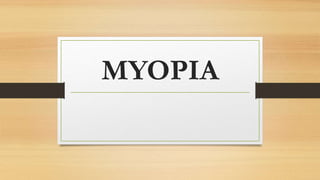Myopia, or short-sightedness, is a refractive error where parallel rays of light focus in front of the retina, leading to symptoms like poor distance vision and night blindness. It can be classified into various types such as axial, curvatural, and congenital myopia, with treatment options including optical methods like concave lenses and surgical procedures. Preventive measures and visual hygiene are also recommended to manage and slow down progression.
















































